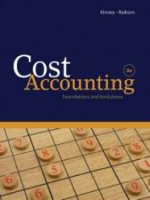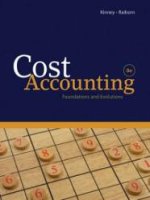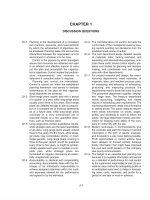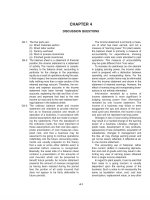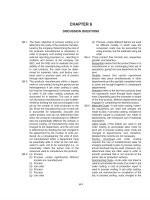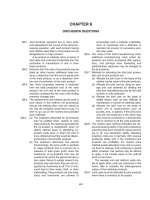Solution manual cost accounting by LauderbachINTRODUCTION
Bạn đang xem bản rút gọn của tài liệu. Xem và tải ngay bản đầy đủ của tài liệu tại đây (124.5 KB, 11 trang )
CHAPTER 1
INTRODUCTION
11 Everyday Planning and Control
(a) Plans for taking a course in college include the amount of time to
devote to it and to other courses. These plans follow the lines indicated in
the chapter. Students formulate objectives for grades, for the knowledge to
be gained for its own sake, for future courses, and so on. They evaluate
their personal strengths and weaknesses to determine how much work to do.
Examinations provide feedback on the sufficiency of work being done;
test results might indicate that more, less, or the same amount of work
should be devoted to the course. Such evaluations can be made whether the
major objective is to gain knowledge or just to obtain a particular grade.
(b) Planning for a long automobile trip involves such matters as the amount
of time to be spent on the road, the desired time of arrival, the cost of
various services along the way (gas and oil, lodging, food, tolls, etc.), the
value of taking various routes, and so on. Each of these factors can be
affected by the objectives of the trip. A trip home from college is usually
made because the student would rather be at home than at school, so time in
route is more critical than if one were simply touring the country between
school and home. The costs involved in various alternative routes and
schedules are important whatever the purpose of the trip, and influence
decisions regarding route, lodgings, and food.
During a long trip, you would examine results to see if you were meeting
your objectives. If the trip were taking too long, some actions might be
indicated, such as taking a shorter but less scenic route, or more costly but
faster toll roads. Again, evaluations of strengths and weaknesses are
important; financial resources, the quality of the car, one's ability to
drive under different conditions, and the possibility of emergencies
developing are a few concerns that you need to consider in selecting a route.
(c) Decorating one's own apartment is very much goaldirected; the apartment
or room must satisfy several demands. It must be pleasant to live and
entertain in, yet it must be within one's means. Once the tenant has set
objectives, the remaining steps include formulating plans to meet them, such
as examining colors, types of furniture, lighting, floor covering, pictures
and other wall decorations to see if they fit the objectives.
Provided that the selected elements meet price requirements, the work
can proceed; but as it does, evaluations will be made regarding the effects
being created. A picture or rug that looked perfect in the store might look
terrible in the room and modifications will be needed. Some decisions made
during the planning process may be irrevocable; the cost of installing wall
towall carpeting is committed, while a piece of furniture might be
exchanged. Furniture and pictures can be moved once they are obtained, but a
11
new doorway broken through a wall cannot easily be shifted a few feet to the
left.
(d) The lines of reasoning are about the same as with the other items. The
coach must evaluate the available resources (players), plan how to gain the
best results from them, ensure that the players follow the plans, evaluate
the results of using particular plans, and modify plans. For example, a coach
of a football team may stress a running game or a passing game, depending on
the talents of the players. If the players tend to be fast but small, one
defensive arrangement may be better than others.
It is also necessary to examine the environment—in this case, the other
teams that will be played. The plan for a particular game will depend
largely on the team being played and on weather conditions. If the opponent
rarely passes, the coach might bring defenders closer to the line of
scrimmage to stop the runners. As play progresses (interim evaluations), the
coach might see weaknesses in the other team and develop a different
strategy.
Note to the Instructor: When studying a new subject, students benefit
from seeing that they already have a basic framework from which to proceed.
Though this question is not about businesses or other organized economic
entities, it focuses attention on the universality of processes described in
the chapter. Each activity has objectives and goals, requires formulating
plans, entails the evaluation of available resources and consideration of
alternatives, goes on over time during which interim results will become
known, can be evaluated in reference to plans, and may require modifications
of planned actions. You might want to interject questions or comments
relating more specifically to organized economic activities. Several parts
of the question deal specifically with economic problems, at least to the
extent that financial considerations are important.
12 Ethics
(a) Wright has violated both the confidentiality and integrity standards.
He has disclosed confidential information and has used it to profit, or at
least as a repayment for his sister's favors. He has also acted in a way
that discredits the profession and has accepted gifts (tips from his sister)
that influenced his actions.
(b) Roberts has violated the competence, integrity, and objectivity
standards. He failed the competence standard by not preparing a report that
used all relevant information. He failed to communicate unfavorable
information, actively subverted the organization's objectives by trying to
influence it to accept a project it should reject, and probably did so in the
hope of a quid pro quo from his superior. These acts violate the integrity
standard. He did not disclose all relevant information, nor communicate it
fairly and objectively. The objectivity and competence standards appear to
overlap in the area of reporting and disclosure, but Roberts seems to have
hit a trifecta.
13 Who Needs Financial Accounting?
Because bankers, suppliers, stockholders, and other external parties use
financial accounting information to help make decisions that affect the
company, the company's managers should understand what that information is,
12
how it is used, and how management decisions will affect it. That
understanding is particularly important to the topmost managers, whose
responsibilities encompass the entire entity. But lowerlevel managers also
need such an understanding, not only because they may aspire to the higher
level positions, but also because the decisions made by managers at all
levels are the source of the economic events that are reported in the typical
financial accounting statements made available to outsiders.
Note to the Instructor: You might wish to use this question to review
the types of external parties whose decisions affect the future of the entity
and how those decisions relate to decisions made by management. For example,
you might discuss, in general terms of course, how a decision to bring out a
new product might require not only additional funding (a decision of a banker
or potential stockholder) but also dealing with new suppliers (who are
concerned with the company's credit rating and liquidity) and new customers
(who are concerned about the company's stability). It may not be too early
to point out that many large companies operate subunits as near independent
entities, and that the managers of those subentities might report to the
larger entity as if it were "the outside world." Finally, some instructors
might wish to point out that since, as the chapter states, some of the
reports used in managerial accounting (income statement, balance sheet, cash
flow statement) are similar to reports studied in financial accounting, a
manager must learn the basic elements of such reports during the study of one
subject or another.
14 Conventional versus WorldClass Manufacturing
(a) Product warranty costs should be lower because a WCM will make
fewer defective products.
(b) Salaries of quality control inspectors should be lower because a
WCM will have its workers inspect as they go, rather than having separate
inspections. Nor will a WCM inspect incoming materials and components
because it will deal only with vendors whose quality has been demonstrated.
(c) Amounts paid to vendors for parts and components should be higher
because a WCM will not search out the lowest prices, but will seek high
quality components delivered when needed.
(d) Wage rates for direct laborers should be higher because a WCM's
workers will be multiskilled and should therefore command premium wages.
(e) Total supervisory salaries should be lower because a WCM's workers
will not need as much supervision.
(f) Warehousing costs should be lower because a WCM will produce as
needed and so will not require storage space for materials or finished
product.
15 Value Chain
(a) Acme Motors’ quality costs should decrease. Acme will need to
spend less on inspecting incoming goods for quality. There should be less
waste on the production line due to poor quality parts.
(b) Quality costs for the suppliers will increase. Eventually the
13
prices being charged Acme will increase as well to cover the increased costs
by the suppliers. The net result to Acme Motors is decreased internal quality
costs somewhat offset by the increased prices charged by the suppliers.
16 Review of Financial Statement Preparation (40 minutes)
1.
Freeport Company Income Statement
for the Year 20X2
Sales $225,000
Cost of goods sold 145,000
Gross margin $ 80,000
Operating expenses:
Depreciation $ 20,000
Interest 3,500
Other 35,000
Total operating expenses 58,500
Income before taxes $ 21,500
Income taxes (@ 40%) 8,600
Net income $ 12,900
2.
Freeport Company Balance Sheet
as of December 31, 20X2
Assets
Current assets:
Cash (a) $ 13,500
Accounts receivable (b) 30,000
Inventory (c) 30,000
Total current assets $ 73,500
Property, plant, and equipment: (d)
Cost 290,000
Less accumulated depreciation 124,000
Net property, plant, and equipment 166,000
Total assets $239,500
Equities
Current liabilities:
Accounts payable (e) $ 18,000
Taxes payable 8,600
Total current liabilities 26,600
Longterm debt:
Bonds payable, 7%, due 20X5 50,000
Total liabilities $ 76,600
Stockholders' equity:
Common stock, no par value, 5,000 shares
authorized, issued, and outstanding 100,000
Retained earnings 62,900
Total stockholders' equity 162,900
Total liabilities and stockholders’ equity $239,500
14
(a) Computation of cash
Balance, beginning of year $ 10,000
Collections on account 220,000
Total available 230,000
Disbursements:
For accounts payable $132,000
Expenses 35,000
Taxes 11,000
Fixed assets 30,000
Interest ($50,000 x .07) 3,500
Dividends 5,000
(216,500)
Balance, end of year $ 13,500
(b) Computation of accounts receivable
Balance, beginning of year $ 25,000
Sales 225,000
250,000
Collections (220,000)
Balance, end of year $ 30,000
(c) Computation of inventory
Beginning inventory $ 35,000
Purchases 140,000
Cost of goods available 175,000
Cost of goods sold (145,000)
Ending inventory $ 30,000
(d) Computation of property, plant, and equipment
Accumulated
Cost Depreciation
Balance, beginning of year $260,000 $104,000
New equipment 30,000
20X2 depreciation 20,000
Balance, end of year $290,000 $124,000
(e) Computation of accounts payable
Balance, beginning of year $ 10,000
Purchases 140,000
150,000
Payments to suppliers (132,000)
Balance, end of year $ 18,000
(f) Computation of retained earnings
Balance, beginning of year $ 55,000
Net income 12,900
Dividends declared (5,000)
Balance, end of year $ 62,900
15
Note to the Instructor: The time spent to cover this assignment might be
used in the following ways.
1. Reviewing basic material on financial reporting, such as the following:
(a) The singlestep and multiplestep income statement formats.
(b) The combined statement of income and retained earnings that reports
activity on a single statement, leaving the balance sheet for "positions."
(c) Disclosure details, such as classes of fixed assets, depreciation, and
inventory methods, etc.
(d) The distinction between the accrual and cash bases of accounting.
2. Leading the students into questions of managerial accounting, such as:
(a) Does the income statement you have prepared help you determine what
income would be in 20X2 if sales had been higher (lower) than expected?
(b) Was there a need for shortterm borrowing during 20X2?
(c) Were the purchases of fixed assets wise?
17 Review of the Statement of Cash Flows (25 minutes)
Freeport Company
Statement of Cash Flows for the Year 20X2
Net cash flow from operating activities:
Net income $12,900
Adjustments for noncash items included in income:
Depreciation 20,000
Increase in accounts receivable (5,000)
Decrease in inventory 5,000
Increase in accounts payable 8,000
Decrease in taxes payable ( 2,400)
Net cash provided by operations 38,500
Cash flow for investing activities
purchase of new plant and equipment (30,000)
Cash flow for financing activities
payment of dividends (5,000)
Net increase in cash $ 3,500
Beginning cash balance 10,000
Ending cash balance $13,500
One profitable area for class discussion is the relationship of profit
and cash flow. The company earned $12,900, but its cash increased by only
$3,500. You might point out that the company's cash flow from operations was
considerable ($38,500), but that purchases of plant and equipment and the
payment of dividends were the principal reasons for the lesser increase in
cash.
16
18 Review of Financial Statement Preparation (40 minutes)
1. St. Francis Company
Income Statement
For the Year 20X2
Sales $960,000
Cost of goods sold 480,000
Gross margin 480,000
Operating expenses:
Depreciation $80,000
Interest 24,000
Salaries and wages (f) 180,000
Other (g) 146,000 430,000
Income before taxes 50,000
Income taxes (40%) 20,000
Net income $ 30,000
2. St. Francis Company Balance Sheet
As of December 31, 20X2
Assets
Current assets:
Cash (a) $ 84,000
Accounts receivable (b) 260,000
Inventory (c) 200,000
Prepaid expenses 12,000
Total current assets $556,000
Property, plant, and equipment:
Cost (d) $760,000
Less accumulated depreciation (d) 340,000 420,000
Total assets $976,000
Equities
Current liabilities:
Accounts payable (e) $100,000
Taxes payable 20,000
Accrued expenses 14,000
Total current liabilities 134,000
Longterm liabilities:
Bonds payable, 6%, due 20X4 400,000
Total liabilities $534,000
Stockholders' equity:
Common stock, $10 par value, 24,000 shares
authorized, issued and outstanding $240,000
Retained earnings:
Balance at beginning of year $182,000
Net income 30,000
212,000
Dividends 10,000
Balance at end of year 202,000
Total stockholders' equity 442,000
Total liabilities and stockholders’ equity $976,000
17
(a) Computation of cash
Balance, beginning of year $ 40,000
Collections on account $860,000
Issuance of common stock 80,000
$940,000
Total available 980,000
Disbursements:
Accounts payable $420,000
Other expenses 130,000
Prepaid expenses 12,000
Salaries and wages 190,000
Taxes 50,000
Plant and equipment 60,000
Interest ($50,000 x .07) 24,000
Dividends 10,000
(896,000)
Balance, end of year $ 84,000
(b) Computation of accounts receivable
Balance, beginning of year $160,000
Sales
960,000
1,120,000
Collections
(860,000)
Balance, end of year $260,000
(c) Computation of inventory
Beginning inventory $240,000
Purchases 440,000
Cost of goods available 680,000
Cost of goods sold (480,000)
Ending inventory $200,000
(d) Computation of property, plant, and equipment
Accumulated
Cost Depreciation
Balance, beginning of year $700,000 $260,000
New equipment 60,000
Depreciation expense 80,000
Balance, end of year $760,000 $340,000
(e) Computation of accounts payable
Balance, beginning of year $ 80,000
Purchases 440,000
520,000
Payments to suppliers (420,000)
Balance, end of year $100,000
18
(f) Computation of salaries and wages
Balance, beginning of year $ 24,000
Payments (190,000)
(166,000)
Balance, end of year ( 14,000)
Salaries and wages expense for the year $180,000
(g) Computation of other expense
Prepaid expenses, beginning of year $ 16,000
Other expenses, paid in cash 130,000
Total, other expenses $146,000
19 Review of the Cash Flow Statement (20 minutes)
St. Francis Company
Statement of Cash Flows for the Year 20X2
Net cash flow from operating activities:
Net income $30,000
Adjustments for noncash expenses and
revenues included in income:
Depreciation 80,000
Increase in accounts receivable (100,000)
Decrease in inventory 40,000
Decrease in prepaid expenses 4,000
Increase in accounts payable 20,000
Decrease in taxes payable (30,000)
Decrease in accrued payables (10,000)
Net cash provided by operations 34,000
Cash flow for investing activities:
Purchase of new plant and equipment (60,000)
Cash flow from financing activities:
Issuance of common stock $80,000
Payment of dividends (10,000)
Net cash inflow from financing activities 70,000
Net increase in cash $44,000
Beginning cash balance 40,000
Ending cash balance $84,000
110 Different Costs for Different Purposes (15 minutes)
1. Virtually zero; to be precise, the cost of gas to go the extra mile to
the friend's house and back to your own house.
2. $7.50 for gas (150 miles/30 miles per gallon = 5 gallons at $1.50 =
$7.50).
Note to the Instructor: The concepts of allocated costs and
differential costs are introduced in Chapters 35, but students should have
little difficulty understanding the points raised here. To concentrate on
the main points, we did not list other costs that would vary with miles
driven, such as oil and tires. Some students will see that some other costs
would be incurred in making the trip as opposed to not making it. A few
might think of opportunity costs in the form of lost income from a job, or of
19
the alternative value of time spent driving instead of doing something more
pleasant.
111 JIT (15 minutes)
Manager A said that the company could not time production just right, so
buffer stocks are needed to prevent workers from falling idle.
JIT principles do not permit extra inventory because it hides defects and
is wasteful. The company now pushes goods through, rather than pulling them
through. Eliminating inventories at work stations will force the company to
maintain high quality and "do it right the first time."
Manager B said that some current problems were caused by poor product
design.
JIT requires close cooperation between design and manufacturing, so that
products will be relatively easy to make and will not fail because of design
or manufacturing flaws. Customers might be persuaded to buy standard
products if they can benefit. JIT does not permit any one area (design,
production) to impose its perceived requirements on another area.
The quality control manager discussed the sophistication of the company's
inspections.
JIT manufacturers do not use vendors whose shipments include defects,
eliminating the nonvalueadding activity of inspecting incoming shipments.
Workers inspect products as they proceed through the factory, so that no
defectives go from one station to another. This practice eliminates the need
for final inspections. The company now finds 10%15% defectives at the end
of the process, which greatly increases its costs.
The production manager spoke about the functional arrangement of
machinery.
JIT manufacturers use cells that perform all of the work on a product.
This reduces the need to move product from one station to another, allows
workers more flexibility in job assignments, and saves space. Workers should
do better under the JIT system because they learn more skills and become more
valuable to the company.
112 Ethics (5 minutes)
Much as you might like to, you cannot tell your father to sell (and then
to sell short) without violating the Standards and becoming liable for
criminal prosecution under insider trading rules. (Most students will not
know about insider trading.) The situation is a moral dilemma. And it is
doubtful that your father will understand your failure to tell him when he
loses most of his investment.
The confidentiality standards explicitly prohibit "disclosing
confidential information acquired in the course of their work . . . " and
"using or appearing to use confidential information . . . for unethical or
illegal advantage either personally or through third parties." The latter
provision probably applies even if the management accountant does not gain
from the disclosure. (The person in the current situation could gain through
110
inheritance if the father's estate benefits from selling the stock.)
113 Ethics (10 minutes)
1. The issue here is not that the lunch is an unacceptable gift that
compromises Taylor's integrity. Many students will say Taylor committed no
breach because the gift of a lunch is negligible. Rather, Taylor might have
violated the Standards because she did not disclose her interest. She did
not, as required by the objectivity standard, "disclose fully all relevant
information that could reasonably be expected to influence an intended user's
understanding of the reports, comments, and recommendations presented."
Taylor might not have done anything culpable, but she should have known
better. Whether the final decision would have changed had Taylor revealed
her friendship is debatable, but the point is whether the managers making the
decision might have thought differently had they known about the friendship.
2. Taylor is now clearly in violation of the integrity standard that
prohibits accepting ". . . any gift, favor, or hospitality that would
influence or would appear to influence their actions." The amount of the
gift is now relevant, as, of course, is the failure to disclose the
friendship.
114 Conventional and JIT Manufacturing (15 minutes)
The memorandum might cover the following points.
Updating designs to meet customer suggestions without considering
manufacturability, effects on cycle time, cost, and effect on operations is
unwise. A JIT manufacturer ensures that design and manufacturing coordinate
activities.
Jason warehouses materials and components. A JIT manufacturer orders
stock as needed, eliminating the handling and storage. Jason goes to great
lengths to get the best prices on materials and components. A JIT
manufacturer is more concerned about quality and meeting delivery schedules.
Jason deals with many suppliers, while a JIT manufacturer deals with
relatively few.
Jason inspects all incoming shipments, while a JIT manufacturer stops
inspecting once it determines that a vendor delivers defectfree components.
Jason also inspects for deterioration before it puts components into process,
which a JIT manufacturer would not tolerate.
Jason maintains inventories at work stations, has long setup times, and
considerable moving of goods during production. A JIT manufacturer keeps no
inventories at stations, strives for short setup times, and manufactures in
cells, which minimizes handling, among other advantages.
Jason inspects at the end of production, while workers in a JIT
environment inspect continually. Continual inspection makes possible keeping
little inventory and eliminating separate inspection. Moreover, Jason cannot
always identify the source of a defect, while a JIT manufacturer can do so.
Jason's cycle times are much higher than those of a JIT manufacturer.
111
